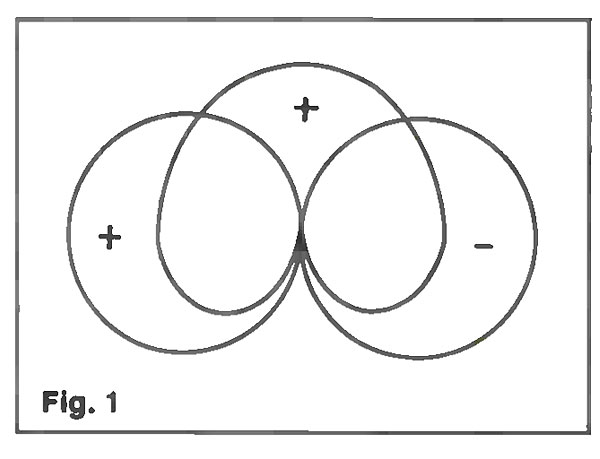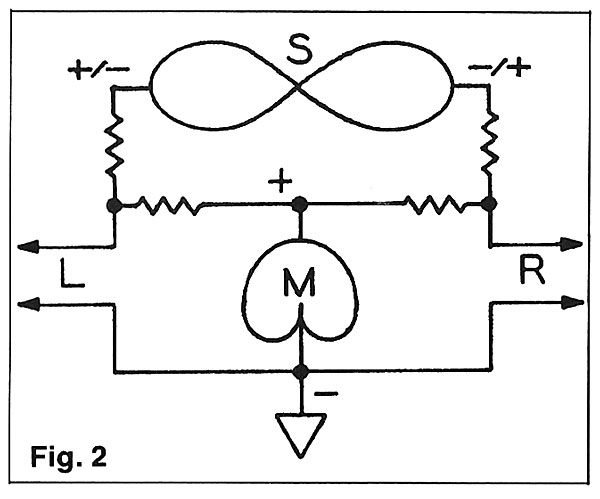| Columns Retired Columns & Blogs |
Fostex M22RP/S M-S microphone

Coincident stereo miking (footnote 1) has two advantages and one disadvantage. Its advantages are that it gives the most stable, specific imaging of any mike technique, and its outputs can be summed for mono reproduction without loss of quality. Its disadvantage is that, in most of its configurations, it tends to produce an overly narrow, shallow soundstage. Crossed figure-8 microphones produce adequate soundstage width, but their rear sensitivity makes them susceptible to audience noise interference at live concerts, and they may pick up too much hall sound at distances which provide the best balance of sounds coming from the front.
Footnote 1: See John Atkinson's discussion of coincident stereo microphone techniques here.
Of all the coincident-mike arrangements, the most satisfactory and most versatile is the so-called M-S configuration, which stands for middle-side or mono-stereo, depending on who you ask. (Actually, mono-stereo is a misnomer, because it doesn't put out a stereo signal at all; it puts out two mono signals.) An M-S mike consists of two separate microphone elements, one a cardioid directional type aiming forward, the other a figure-8 bidirectional type aiming to the sides (fig.1).

A bidirectional mike is sensitive to sounds coming from both sides, but the electrical polarity of its output depends on which side the sound is coming from. This is because a pressure wave from, say, the left side will move its diaphragm in the opposite direction from a pressure wave coming from the right side. And since there are only two possible polarities for connecting anything, only one side of the figure-8 mike can be in-phase with the front-facing cardioid mike when a sound comes from in front. As you can see, there is no way this configuration can give us a stereo pair of output signals. To do this, the outputs from the two mikes must be matrixedµadded and subtracted. Fig.2 shows an oversimplified version of the matrixing network; here's how it works:

The M mike is wired according to professional convention so that a compression wave causes a positive-polarity output. The S mike is wired so that a compression from its left side also produces a positive output. When a sound source is directly in front of the two-mike array, there is output from the M mike but none from the S mike, because the latter is sensitive only toward the sides. (In effect, the opposite-polarity sides cancel sounds coming from the front.) When this is the case, the matrix puts out equal L and R signals. When the sound source moves off to the left, the M mike's output is augmented by in-phase signal from the S mike at the L output, and attenuated by the out-of-phase S signal at the R output. The L output becomes stronger than the R. When the sound source moves to the right of center, the S-mike output reverses polarity, causing attenuation in the L output and augmentation in the R output.
The electrical matrixing offers some intriguing possibilities. The amounts of cancellation or reinforcement which occur in the matrix are going to depend on the relative amplitudes of the M and S signal components. At one extreme, if we eliminate all of the S signal, we get pure two-channel mono, just as though the S mike were not present at all. And because the M mike is directional, and aimed forward, that mono sound will be very dry and lacking in hall ambience. At the other extremeµeliminating the M component altogetherµwe get no shared (common, or sum) information at all; the output signals are pure ambient stereo, with no front-center information. And because there is practically no pickup from in front, where the performers are, the sound will be very distant, as though the microphone is a long way back in the hall. In between those extremes, there is an infinite range of mixtures offering considerable control over the soundstage width and the apparent distance between the mike and the performers.
M-S miking has other advantages over other coincident configurations, too. Because the cardioid mike is aimed directly at the performers, it is not subject to the sonic colorations introduced by a directional mike's changing off-axis frequency response. With X-Y cardioids, for example, a centered sound is in the region of both mikes' 3dB midrange attenuation points, where HF response is typically even more attenuated than 3dB. With an M-S mike, center front is directly on the axis of the M mike, where overall frequency response is (usually) at its flattest.
The Fostex M22RP/S is a ribbon mike, but it's nothing like the fragile ribbon mikes of yore, with their tissue-thin diaphragm that would blow away in a modest breeze. The "ribbon" in this Fostex mike is actually a metal-printed plastic diaphragm, more like a tiny Apogee woofer than a Magnepan tweeter. It is virtually indestructible, in fact. It also has unusually high output for a ribbon (footnote 2)µabout 10dB more than that of early ribbon designs. And, perhaps as a result, it has extremely low noiseµan essential quality in this age of 94dB digital dynamic range.
The mike is supplied in a very rugged, foam-lined aluminum carrying case, along with 10 feet of 5-conductor (including shield) cable and a matrix box, which latter delivers standard L and R stereo outputs. (An adaptor is available from Fostex, to allow the mike to deliver M, -S, and +S outputs.)
Testing
Before venturing afield with the Fostex mike, I made some in-house test recordings to determine its imaging accuracy, setting it up symmetrically with respect to the normal loudspeaker locations in my listening room, and speaking from various marked (on the floor) locations on and off its center line. I then moved the speakers back into place, replayed the tape, and noted how well the perceived images tracked their original locations. They were right on target. With the mike in the same location, I then recorded some wide-range material from my speakers and played it back through the same speakers. This is really a nasty test of the speakers and listening room, as it effectively doubles every coloration. But the reproduction was surprisingly like the "original" heard from where I placed the mike. It was then, however, that I first became aware of a certain weakness in the mike's low end. Bass drum and bowed basses sounded a little thin.
For my final tests, I used the mike for that which it was intended: live recordingµin this case, of a local symphony orchestra. Because the orchestra management prohibits the use of microphone stands during performances, I had to be content with recording two rehearsals, during which I could put a single, high stand where I bloody well pleased. The mike was placed about 15 feet behind the conductor and 10 feet higher than his head, and aimed slightly downward so the vertical axis of the M mike was targeted on the rearmost row of instruments. (The hall is a little on the dry side, but with a smooth decay free from slap or buzzes.)
The results were remarkably good. Overall, the spectral balance was quite similar to what I had heard, live, an hour or so before auditioning the playbacks. The sound was brightµa little weighted toward the upper midrange/lower highs, which was exactly how it had sounded in person. But there was no question about the mike's thin low end. Double basses sounded somewhat lean, and the bass drum was distinctly gutless and lacking in impact and heft. Also evident was a not-too-subtle rounding-off of highs and transient information, as though the mike was just a shade slow to react. Imaging was quite extraordinary in every wayµspecificity, stability, and perspective. The mike even did a very good job of reproducing depth, perhaps contrary to expectation, but then my speaker system is set up to exaggerate depth a little bit, with its electrostatic panels about 8 feet out from the rear walls.
How about soundstage width? Harry Pearson, writing in The Absolute Sound, has often claimed that any loudspeaker worth considering should be capable of imaging beyond the lateral positions of the loudspeakers. Since this is supposedly a physical impossibility with "normal" stereo recordings, I used to attribute what he was hearing to the SQ surround-sound encoding on the EMI recordings he usually reported hearing it from. But I have since heard it on a few unencoded recordings made with purist-type "minimalist" mike techniques. And I heard it again with the Fostex M-S mike.
At one point while listening to my orchestra-rehearsal tape, there was a lull in the proceedings during which I could hear two people conversingµfrom about 70° off center to my right! Then I remembered that they had been standing in front of the entrance doors at the right of the hall during that part of the rehearsal! I still do not know how this can happen, particularly with mikes that are as phase-coherent as coincident types, but I heard it. And, amazingly, it's firm; if you turn your head to face it, it's still there. But there was no question that the Fostex M-S mike does not compress soundstage width. In fact, its re-creation of all spatial cues is as accurate as any stereo mike setup I have used.
I am not equipped to play creative games with M-S signals (footnote 3), but I can say that Fostex's choice of matrix values is ideal for the most accurate replication of directional information. I was so impressed that I was tempted to buy the thing, and would have were it not for its other small weaknesses: the LF deficiency and overall slight lack of detail and openness in comparison with the best condenser mikes. (Some of those, such as the Schoeps Collettes, sound as if they have no upper limit; the Fostex sounds as if it does.) I didn't try the mike on pipe organ, but could only expect it to fare even worse with a soundsource capable of generating an honest, gut-shaking 32Hz.
Summing Up
I'm aware that the Fostex M22RP/S is not designed for perfectionist recordists, but for the film and TV user, for whom LF extension is rather low on the priority list. But this mike does so many things that critical audiophiles demand, and does them so well, that it seems a shame to have to dismiss it because it doesn't handle bass as well as some cheaper condenser types that have terrible high-end performance. Oh well, c'est la vie.
Footnote 1: See John Atkinson's discussion of coincident stereo microphone techniques here.
Footnote 2: Microphone output ratings are not standardized and are difficult to translate. Some ratings specify open-circuit output voltage at one SPL or another, some use dB below 1 milliWatt (dBm) at 1 dyne/cm2 sound pressure, others use the same thing but at 10 dynes/cm2. A few even use the EIA standard spec: dB relative to 1 milliwatt for a sound pressure of 0.0002 dyne/cm2. Why, I have to inquire, don't they all?
Footnote 3: Devices which allow one to adjust M-S matrixing proportions are available from Audio Engineering Associates, 1029 N. Allen Ave., Pasadena, CA 91104. Tel: (213) 684-4461. Web: www.audioaea.com.
- Log in or register to post comments






















